President Jacobsen Begins Tenure
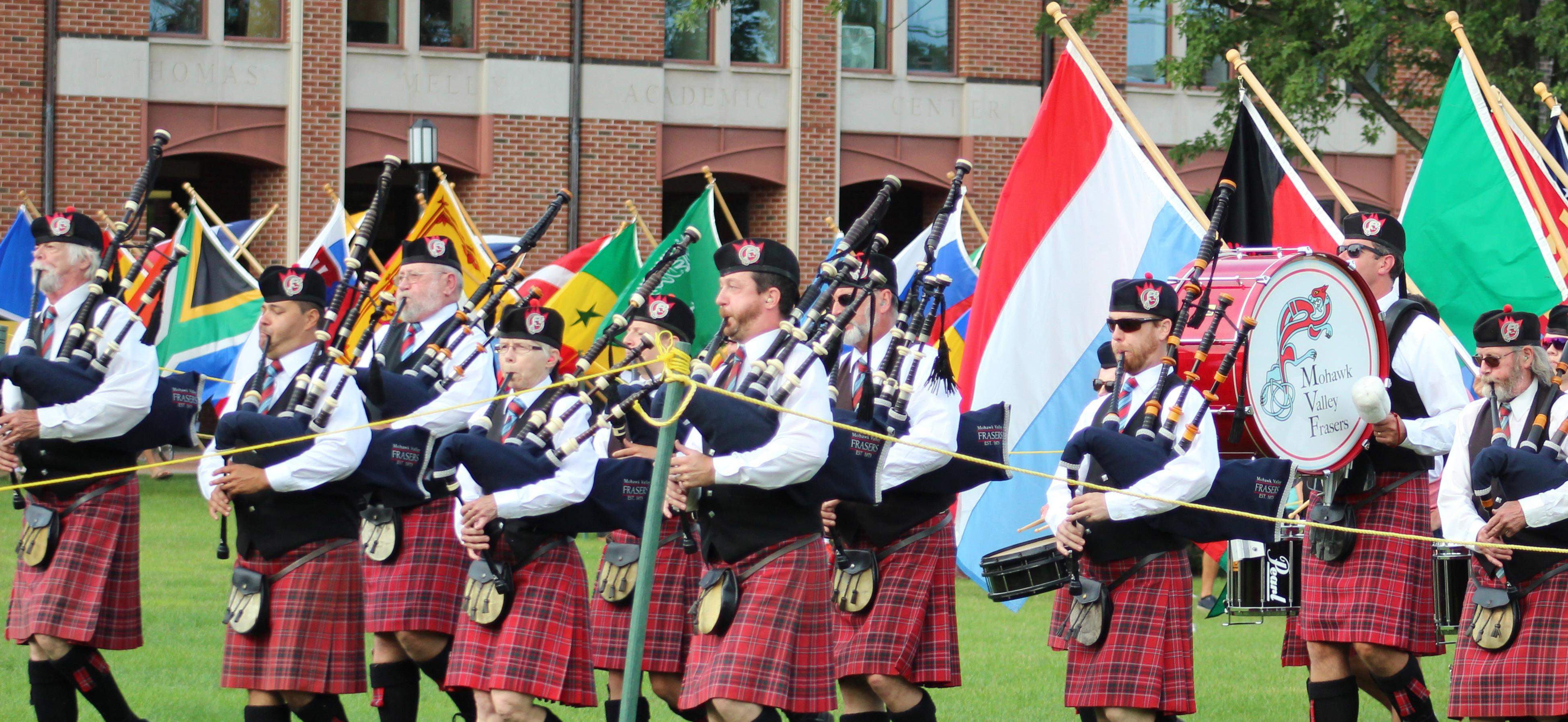
 By Elise Donovan ’22
By Elise Donovan ’22
Within some of her first weeks on campus, President Joyce P. Jacobsen seems as optimistic and pragmatic as she did during her acceptance of the position back in February. In an effort to gauge how her adjustment has been since her arrival, the Herald sat down with the president during her school-wide open office hours.
After being announced as the 29th president of Hobart College and 18th president of William Smith and officially stepping into her position on July 1 of this year, Jacobsen has already outlined much of her vision, as well as established her position as an active resident and participant of the Colleges. Before students arrived on campus, she managed to visit and tour every residence and academic facility on campus. Since the arrival of students she has almost completed her goal of visiting every physical space, with only a few left, such as the solar farm, which she will be visiting soon with Professor Thomas Drennen, who orchestrated
the installation of the farm in 2016.
More than just being physically active on campus, Jacobsen has also established a strong investment into the goals, ideas, and activities of the student body over which she presides. This can be shown in her attendance records at almost all of the current practicing sports teams, as well as a flexible calendar for invitations to other groups and clubs on campus. A recent example was her attendance at the first William Smith Congress and Hobart Student Government joint meeting of the year, where she made herself available to questioning from student government members.
Another one of the primary ways that she intends to continue to cultivate this active presence is through her bi-monthly office hours and open houses. Meant as a time for students to approach the president, whether that is for students who wish to express concerns or those who want to just talk about their day, the open office hours are a sweeping evolution of the president’s role on the HWS campus.
William Smith Students Celebrate with Inductees at NWHF Induction Ceremony
By Gabriel Pietrorazio ’20
William Smith College was wellrepresented with seniors who attended and even coordinated the 27th annual National Women’s Hall of Fame induction celebration that honored 11 exceptional women: Gloria Allred, Angela Davis, Sarah Deer, Jane Fonda, Col. Nicole Malachowski ret., Rose O’Neill, Louise Slaughter, Supreme Court Justice Sonia Sotomayor, Laurie Spiegel, Diane Von Furstenberg and Dr. Flossie Wong-Staal.
Although this feature highlights three seniors and their different experiences at the NWHF ceremony, other students from William Smith College were also in attendance.
Liza Kiernan ’20, a Media and Society major and Women’s Studies minor, was an instrumental character in planning and coordinating the induction ever since she started working at the hall in Seneca Falls this past January.
Starting out as a volunteer with the organization who gave tours to guests and covered the help desk phone, she eventually succeeded former Social Media Director Cassidy DiPaola ’19 and became a staffer, assuming DiPaola’s former title.
In this role, Kiernan assisted in preparing for the ceremony itself by managing the hall’s social media presence, emailing the Board of Directors about the inductees and creating content engagement strategies to promote the event itself.
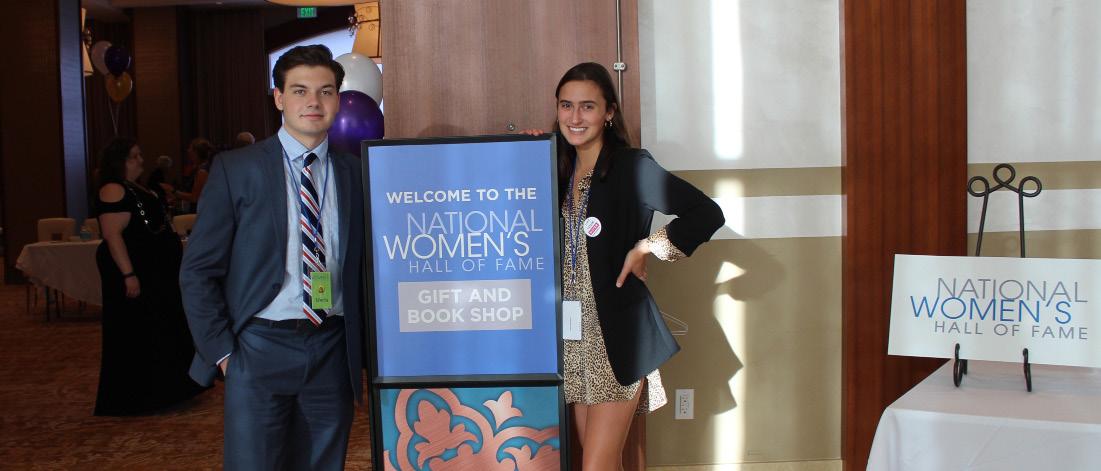
She also had to deal with the swirling controversy after receiving countless forms of mail and calls that complained about the inclusion of Jane Fonda and Angela Davis into this year’s inductee class.
Kiernan was busy all day from as early as 8 a.m. and staying until 9 p.m. on that Saturday
helping her fellow staffers host an “extremely smooth” event at the del Lago Casino & Resort venue.
As someone who actively works at the National Women’s Hall of Fame, Kiernan calls for her fellow peers to visit the museum, especially due to its close proximity to the Colleges.
“I think it is our job to honor [and] appreciate that and honor that as much as we can because it is a great advantage that we live so close to there and we have all of these amazing women passing through every day,” Kiernan said.
Gianna Gonzalez ’20, an English and Media and Society double major and minor in Music, was profoundly impacted and inspired by the illustrious class of women inductees after accepting an invitation to attend the ceremony on behalf of Kathy Reagan, the Chief of Staff to the President of the Colleges.
“The most memorable aspect of the
Later in the semester, as well as throughout the year, Jacobsen will also be hosting class open houses, with each class year being designated a certain date to visit the president, and her famous cat Mr. Butters (@mrbuttershws), at her home on South Main Street. Having hosted a total of two out of seven office hours already this semester, held the first-year class open house, and announced her active and open email address, Jacobsen has made sure to make herself accessible to students.
More than just investing in the interests and opinions of the student body, Jacobsen is also investing in the intellectual and social capital of HWS in both the present and future. When asked about her hopes for the future of the Colleges, she reiterated her pragmatic and consistent approach regarding her many goals. These goals, which encompass everything from new science buildings and equipment to writing a William Smith fight song, are all what we call S.M.A.R.T goals (specific, measurable, achievable, relevant, and time-based). While many are vast in scope, Jacobsen’s first attempt at attacking certain issues is establishing specific task forces. Some task forces already underway are in place to address the use of Fribolin Farm, the hiring of the Chief Diversity and Inclusion Officer, and the search for a new Provost.
In the conclusion of our conversation, President Jacobsen discussed with the Herald the history of the carpet that covered the entirety of her office on the second floor of Coxe, as it has been the matting of more than 25 different HWS presidents. The Herald was intrigued by the office space itself, as most students are likely unaware that Coxe has a second floor or houses the president’s quarters. This epiphany establishes perfectly the type of president Jacobsen hopes to be: Present, Attentive, and Revolutionary.
Convocation p. 3 Orientation p. 4 Standing with Hong Kong & New Faculty Profiles p. 5 Student Election Turnout p. 6 Established 1879 A Voice for the Students NWHF Induction continued on page 3 News
Photo credit: Gabriel Pietrorazio
Herald Staff Herald Staff
Above: Gabriel Pietrorazio ‘20 and Liza Kiernan ‘20
Photo credit: Gabriel Pietrorazio
Photo credit: Gabriel Pietrorazio
The Herald
Established 1879
By and for the Students of Hobart and William Smith Colleges
www.HWSHerald.com

Wren Andrews, Arts & Entertainment Editor
Reed Herter, News Editor
Olivia Rowland, Copy Editor
Russell Payne, Design Editor
Albright Dwarka, Podcast Editor & Web Editor
Gianna Gonzalez, Marketing Coordinator
Audrey Platt, Social Media Coordinator
Contributors
Hrithik Biswas
Julia Cilano
Elise Donovan Cameron Miguel
Layout Russell Payne
Natalie McCarthy Olivia Rowland
Copy Editing
Olivia Rowland
Charlie Wilson
Malika Panjabi
Gabriel Pietrorazio
Olivia Rowland Maya Striuli
Distribution Olivia Rowland Wren Andrews
Submission Guidelines
The Herald is currently accepting submissions for our upcom ing issue. The deadline is Monday at 5 p.m.
Must include the:
1. Name and Class Year
2. Individual phone number or e-mail E-mail submissions must be made via file attachment.
If criteria are not met , The Herald may not be able to print the submission.
Dear Readers,
Welcome back to campus—and welcome to the Classes of 2023—from the new Editorial Board of the Herald! This first issue of the semester will give you an introduction to our paper and to HWS, for all who are new on campus. Just as the Herald has experienced quite a few changes with the beginning of a new school year, so has our school with the arrival of President Joyce P. Jacobsen, a number of new faculty, and another first-year class.
Accordingly, our first issue focuses on many of these changes and new beginnings. Our article about this year’s Orientation and our profile of the Classes of 2023 explore what new students think about HWS so far and why they decided to come here. Two faculty profiles on Visiting Instructor of Anthropology Brian Clark and Instructor of Political Science Ed Quish introduce new faculty and reveal their first impressions of campus. We also delve into President Jacobsen’s (and her cat, Mr. Butters’) busy first few weeks of the semester and her plans for her first year here at HWS.
Because the new semester has brought students new opportunities for political engagement on campus and in the Geneva area, we cover some important ways in which students have been participating (and also not participating) in campus and local politics. Articles in this issue investigate voter turnout in student elections, one student’s response to the ongoing protests in Hong Kong, and William Smith students’ attendance at the National Women’s Hall of Fame induction ceremony.
All of the articles in this issue aim to fulfill the Herald’s goal of being “a voice for the students.” The Herald was founded in 1879 as the Hobart Herald and has been published by the students of Hobart and William Smith Colleges jointly since 1942, making this our 140th year.
As we mentioned above, the Herald has a new Editorial Board this year following the graduation of our previous Editor in Chief, Alex Kerai ‘19. During his tenure as Editor in Chief, Alex took the Herald to a new standard of student journalism that strongly supported our dedication to providing members of the HWS community with trustworthy, factual, relevant, and important news. He led a number of investigations and spearheaded the solicitation of student viewpoints about the coordinate system and race and diversity on campus, which we published last year (and can all be found on our website).
The new Editorial Board hopes to continue what Alex started and make the Herald into, in his own words, “a place for viewpoints and a forum for discussion” meant to inform the HWS community. However, we are still getting the hang of running the Herald—so we ask you to hang in there as we try our best to fill Alex’s shoes.
We also ask, as always, for help from our student readers; to give students a voice, we need student voices in our paper and on our editorial team. If you have any interest or ability in journalism, photography, editing, or layout, please contact us at herald@hws.edu and see our submissions guidelines to the left for news and opinion articles.
We hope that you all enjoy this first issue.
Sincerely,
Reed Herter, News Editor
Wren Andrews, Arts and Entertainment Editor
Olivia Rowland, Copy Editor
FRIDAY, SEPTEMBER 27, 20192
DIGGING-UP CONVOCATION WITH LAMANNA ‘97
By Gabriel Pietrorazio ‘20
This year’s Convocation ceremony welcomed world-renowned paleontologist Matthew Lamanna ’97 to the Colleges.
A Hobart College Class of 1997 graduate, Lamanna issued the Convocation address as its keynote speaker on Monday, Aug. 26.
Throughout his career, he has uncovered fossils on all seven continents—a rarity in his profession—and is the associate curator of vertebrate paleontology at the Carnegie Museum of Natural History in Pittsburgh.
At the beginning of his speech, Lamanna remembered his utter fascination and love for dinosaurs as a child.
He recalled playing inside a sandbox with prehistoric toys when he was younger until one day when his father by accidently purchased a cement mixture that filled-up the box. Once the cement got wet, the toys were encased inside a solid mass.
“Thanks, dad, for sending me on my first dinosaur dig,” Lamanna jokingly said.
Unlike most other children, his passion for paleontology never dissipated and only grew stronger, especially when he started his undergraduate career at the Colleges.
Lamanna joined the Geoscience and Biology departments, earning the backing and respect of their faculty.
While a Ph. D. candidate, Lamanna embarked on an expedition to Egypt in 2000, where he and his peers unearthed a new dinosaur species that was named Paralititan stromeri and later known as the “tidal giant,” a sauropod, or long-necked, plant-eating dinosaur.
In the first few weeks, his crew suffered an onslaught of sandstorms and food poisoning without much reward until they uncovered the new dinosaur.
Weighing in at 40 tons and 90 feet in length, the “tidal giant” was a monumental discovery in the
induction ceremony was how each woman, no matter the field, thanked the women who either paved the way for them or helped them pave the way for others. Whether it was Justice Sonia Sotomayor or Jane Fonda, every speech fueled a desire in me to get to work, support my peers, and do my best to leave the world better than I found it,” Gonzalez said.
“Representing [Regan] at the NWHF induction ceremony as a William Smith student, I was reminded of the duty I have to the women of now and the future to do my part in the fight for women's equality across the board,” she continued.
Emma Consoli ’20, an International Relations major, Women’s Studies and Public Policy minor and Writing Colleague, was also present and energized, full of fervor for women’s equality.
As the senior chapter leader of the Public Leadership Education Network, also known as PLEN, William Smith Dean Lisa Kaenzig requested for Consoli to attend the induction ceremony and reception.
“Being able to meet and talk with Angela Davis, Nicole Malachowski, Sonia Sotomayor, Sarah Deer, and Flossie Wong-Staal was the highlight of the event for me. These women are incredible leaders in the world, and they were all so kind and giving with their time,” Consoli said.
“Our interactions with each of these women was more than just to say hello and take a picture; they all spoke with us, some at length, and talked with us about our goals as strong women moving forward. It was humbling to be in their presence, and inspiring to be able to hear their words of encouragement,” she elaborated.
The most memorable moment for Consoli was when she spoke with Sarah Deer during the reception. Admitting that she was not well aware of Deer’s area of study as an Indigenous legal scholar and activist beforehand, Consoli was quickly inspired by Deer’s acceptance speech and call to action to end gender-based violence towards Indigenous women.
Consoli shared that Deer met with each of the William Smith students during the reception following the ceremony, urging them to consider visiting the University of Kansas for a master’s program in Gender Studies where she teaches and even offering to bring-out them for a campus visit.
“She said that if we should decide that we either don’t want to go to graduate school, or that Kansas is not the place for us, she would still love to collaborate on work with us moving forward,” Consoli said.
This year marks the centennial celebration of women’s suffrage. Elizabeth Blackwell, an 1847 graduate from the Geneva Medical College, was also inducted into the NWHF years ago.
Many of the William Smith students
paleontology profession.
Since then, Lamanna shared that he has led explorations across to globe to Antarctica, China, Argentina and Croatia.
Although Lamanna and company unearthed a new dinosaur as a contribution to the paleontological record, even as a doctoral student, he was still humble in his remarks at Convocation.
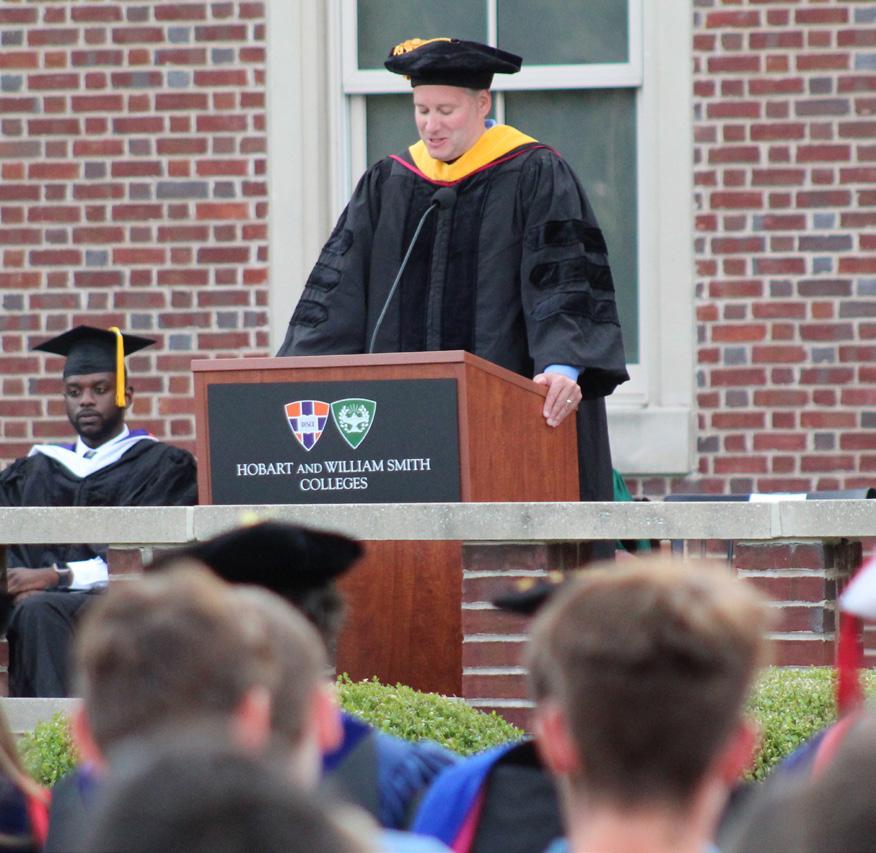
He cited this accomplishment as something he never completed on his own but through the help of others, especially those at the Colleges who provided him with a liberal arts education that ultimately prepared him for making history.
“It takes a village to dig up a dinosaur,” Lamanna said. He continually stressed an emphasis upon being a part of a global community and critically reflecting upon the complicated past associated with colonization and the unethical practices of Western nations claiming dig sites from local communities.
“Exploration should not be at the expense of others,” Lamanna said during his speech.
Lamanna closed his address by acknowledging all of the Argentinians, Egyptians, Croatians and Chinese who aided him at each of his paleontological sites across the world.
A month removed from Convocation, the Herald connected with Lamanna to reminisce about his speech.
In regards to the subject of colonialism, Lamanna later elaborated, “Paleontology has a long history of ‘white dude goes to foreign country or colony, digs up fossil trophies, brings them home to keep, and studies or publishes them on his own.’”
“In other words, American and European paleontologists traditionally haven’t invested very much in the nations in which they’ve worked, nor the people in them. Nowadays more and more Western paleontologists are trying to use our positions of relative privilege to foster the development of paleontological laboratories, museums, research programs, and scientists in the still-economically-
developing countries in which we work. We have a very long way to go, but there have been significant successes,” he further mentioned.
A moment of success for Lamanna lies with fellow collaborator Hesham Sallam of Mansoura University, who educates Egypt’s future of female vertebrate paleontologists.
Trained by a colleague of Lamanna at Oxford University, Sallam has since established “an excellent paleontological program at his home institution.”
“These students—many of whom are women—represent the next generation of vertebrate paleontology in Egypt, and probably the first homegrown, really sustainable paleontological research program in that country. I’m proud to be even tangentially associated with them and I try to do whatever I can to help them out,” Lamanna stated.
Next month in Australia, Lamanna, Sallam and some of his students will present a poster at the annual meeting of the Society of Vertebrate Paleontology on their research conducted in Egypt’s Bahariya Oasis that was sponsored by the National Geographic Society.
When asked to open up about his chance to speak to the Colleges at Convocation, he concluded, “It was great, a true honor. I’ll forever be grateful to Dr. Jacobsen for asking me to speak. It was also awesome to get to know many current HWS students, faculty, and staff, most of whom I’d never met before. I came away thinking that HWS is in very good hands and that its future is looking brighter than ever.”
reflected on the bearing weight of responsibility to be associated to Blackwell as an ambassador to the Colleges.
“Attending the same college that Elizabeth Blackwell attended has been an enormous source of pride for me since stepping on campus. Elizabeth Blackwell was such an incredible person and her legacy has opened so many doors for women. To be able to start my career in the same place that she started hers is inspirational to me in and of itself, and has guided me throughout my time at the Colleges,” Consoli explained.
“Similarly, throughout the ceremony, I was so grateful to be a representative of the next generation of women to emerge from HWS. In a sense, my presence at the event helped to represent the spirit of Elizabeth Blackwell living on through Hobart and William Smith,” she added.
When reflecting on Blackwell and her legacy here at the Colleges, Gonzalez mentioned, “Elizabeth Blackwell continues to inspire me on a daily basis. At HWS, they try very hard to provide equity in leadership opportunities for women, but in the classroom and other public spaces, I am often forced to remind myself of Elizabeth Blackwell. When male privilege is exerted over me on and off campus, Elizabeth Blackwell provides me with an inspiration to fight for myself and others, work hard, and be good at what I do.”
For Consoli, attending the NWHF ceremony during the centennial anniversary of women’s suffrage was a proud moment for her as a William Smith College student.
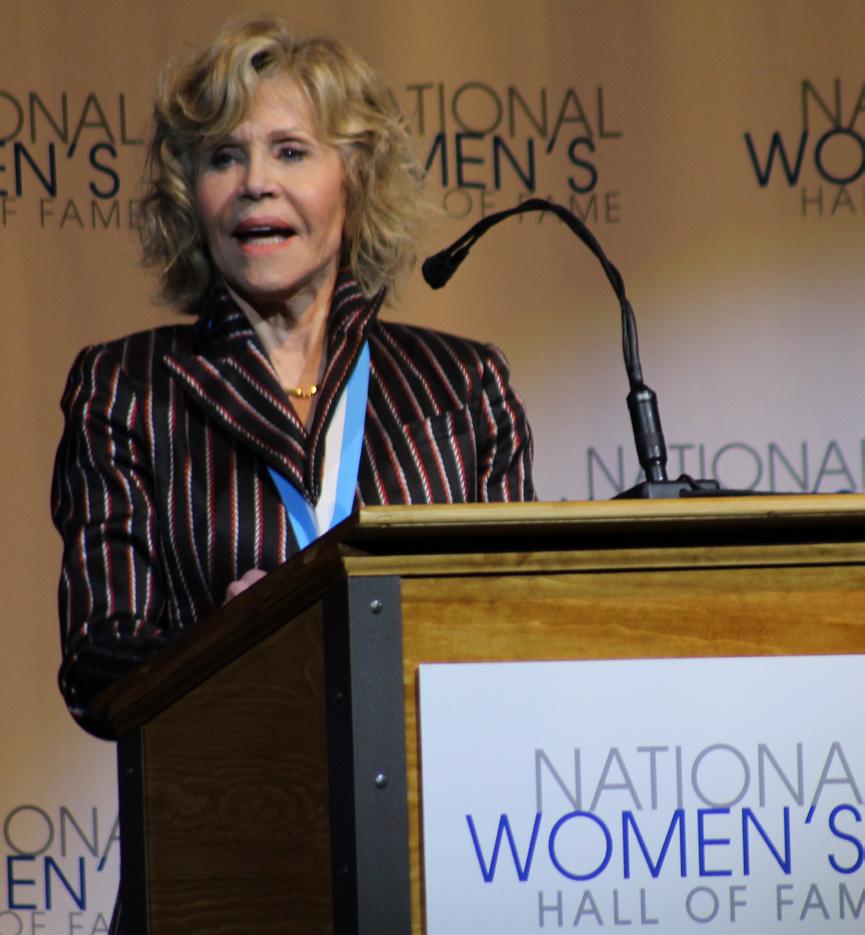
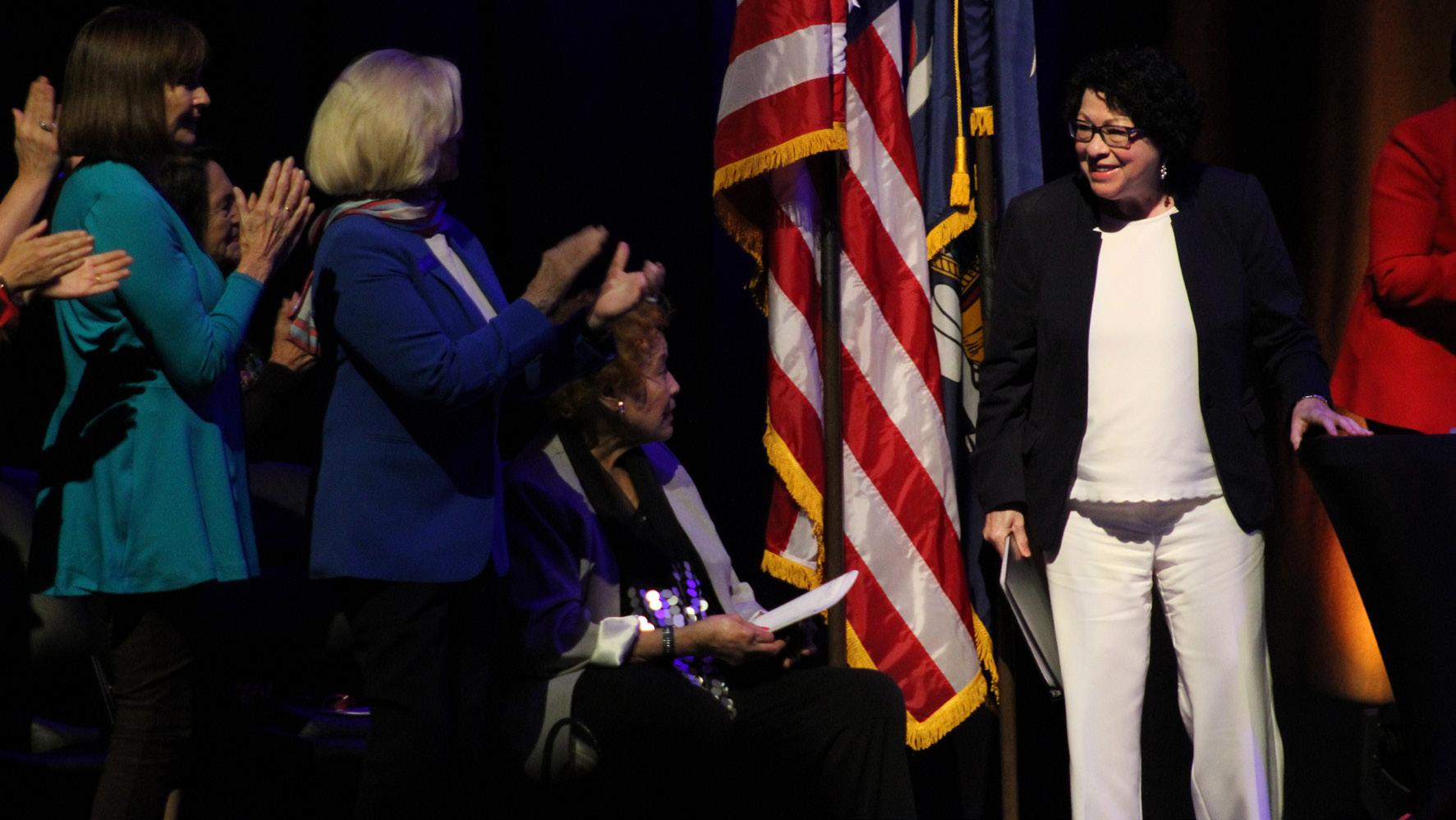
“To be in the place where the suffrage movement started, during the 100th anniversary of the ratification of the 19th Amendment, is so powerful.
As a female-identifying person, and a proud student of William Smith College, I have been
particularly reflective this year about the power of my feminism, my voice, and my activism. I look back to those who have come before me, particularly those who have started here, and I take strength from it. It is empowering to consider them around me as I take on the next step of the fight for equality,” Consoli said.
“I am so appreciative of the work that they did and the ways in which they redefined what it meant to be an activist and a woman. Without them, we would not be where we are today. I also am careful to notice and learn from their mistakes, so that I may take the legacy of their work and success, and help bring it into the modern world. Being in Geneva inspires me to keep challenging the norm, the history, and the precedence, in the way that our forbearers did, and to fight for the correction of injustice, wherever that may lie,” she concluded.
3 FRIDAY, SEPTEMBER 27, 2019 News
NWHF
Induction continued from page 1
Photo credit: Gabriel Pietrorazio
Photo credit: Gabriel Pietrorazio
Photo credit: Gabriel Pietrorazio
Above: Sonia Sotomayor at the NWHF Induction Ceremony
Herald Staff
Above: Jane Fonda at the ceremony
New Students on the Block: Orientation 2019
By Julia Cilano ’23 and Hrithik Biswas ’23
The transition from high school to college is no easy task—upon arriving on campus, first-year students are immediately plunged into a new world and a new way of life with much more freedom, independence, and responsibility. The first-year experience is entirely new and different, and the culture shock is jarring to say the least. Thankfully, Orientation is there to soften the blow and help students acclimate to college life. For four days preceding the start of the academic year, first years and transfer students learn about life at HWS, sign up for classes, participate in community service, and get to know their new classmates.
The Herald surveyed 34 first-year students on what they thought about the Orientation experience. Overall, the students felt that Orientation was a good experience that gave them most of the information they needed to acclimate to college life. They said that it was very organized overall. Students enjoyed the food trucks that were on campus the first night of Orientation and the fun activities that complimented the information sessions. Overwhelmingly, the students in our survey agreed that Orientation was most essential when it helped them make friends and get to know their classmates.
Gill Parrett ’23 agrees. While moving in on the day before Orientation, Parrett met another student on the cross-country team who has become a close friend. “I’ve found someone I can vibe with,” she says.
Parrett’s favorite part of Orientation was the Day of Service, during which she packed food at Bristol Gym. “I found it fascinating to pack 30,000 meals in one hour,” she says. This prompted Parrett to reflect on her own position at the Colleges. “I have the amazing opportunity to attend college and get a meal,” she explains, but “there are people in the world who may not have the opportunity to have food on the table.”
Through the Day of Service, Parrett was able to act on this realization. “I was able to help in some way … And I love that!”
Garret Downs ‘23 had a similarly positive experience of Orientation as a transfer student. Coming from Elmira College, he has experienced two different orientations. Orientation at Elmira was informational and structured, he says, while Orientation at HWS was “fun” and had “an atmosphere of joy.”
Through activities like bumper cars, laser tag, and bowling, Downs grew very close with his transfer OMs and the group very quickly, and he still
makes time to meet with group despite the demands of the academic school year. To him, Orientation centered around meeting new friends and “falling in love with a new place.” He views Orientation as a stepping stone that helped him settle into, understand, and further appreciate the HWS campus and community.
However, students did not have uniformly positive perceptions of Orientation. Most of the students in our survey agreed that Orientation was too long and thought that, instead of the four heavily scheduled days, Orientation should have been only two days long or scheduled with more free time.
Some also disliked the continuation of Orientation through Kaleidoscope, in which students learn about HWS and its community for an hour a week during the first few weeks of the semester. One first year says that “the Kaleidoscope sessions have been very useful, but [they] should be offered during Orientation so that we aren’t trying to work around them once school has started.”
One aspect of Orientation that received few complaints were the Orientation Mentors (OMs). Students largely believed that their Orientation Mentors (OMs) were very valuable in helping them through Orientation. As students, OMs introduce
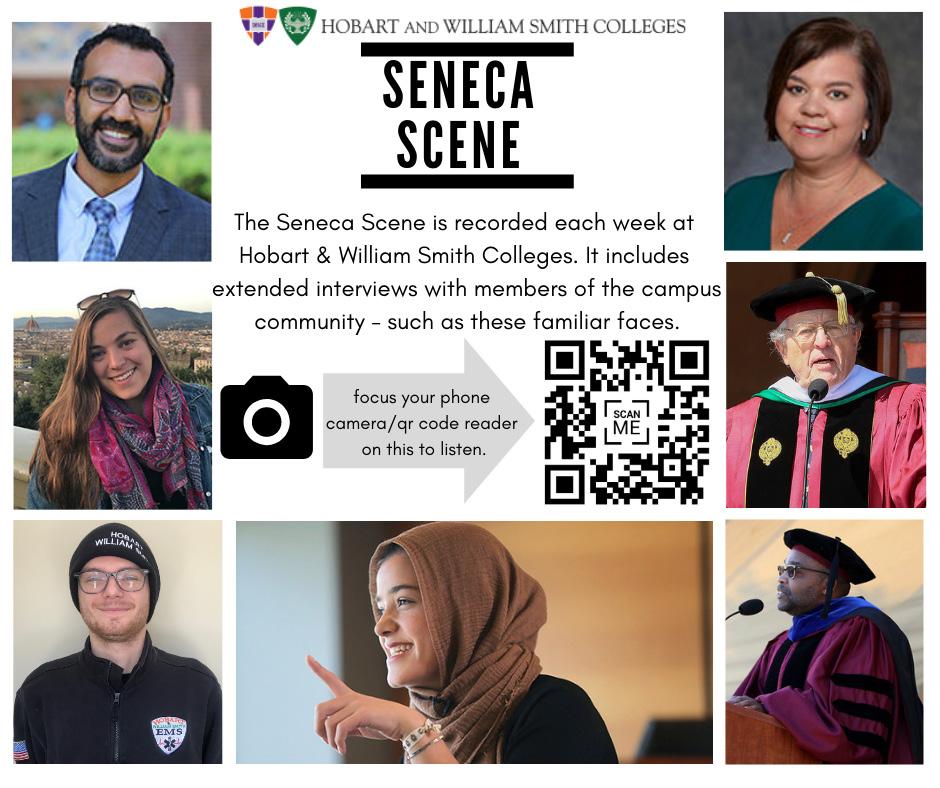
first-year students to campus, the town of Geneva, and the day to day realities of being a college student.
OM Nathan Jacon ’22 drew on his own experience in Orientation to help this year’s firstyear students. “Having just been through my own Orientation last year, I knew the kinds of questions that I get asked,” he says. “This year I was prepared to answer them and help in as many ways as possible.”
Jacon notes that “the transition from high school to college can be challenging and stressful at times, and I wanted to do my best to offer my advice on the best ways to relax and be happy and successful.” He hopes to be a resource that students can reach out to throughout their time at HWS.
The Herald wishes everyone in the Colleges a successful and healthy academic year. For the first years starting their journeys: the journey through the Colleges will be a place to learn, grow, and make meaningful relationships. Life is about making memories, laughter, and happiness, and enriching our souls with intellectual conversions. Take advantage of the opportunities around you and never forget who you are as a person. We hope your curiosity continues to make the Colleges a welcoming and dynamic place to be.
Come and visit our Quaker community
What do Quakers believe?
We believe all people can have a direct experience of the Divine, individually and in shared worship. We believe everyone is equal. We look for the Divine in every person we meet. Our guiding principle is love
Professor Profile: Brian Clark, Anthropology
By Cameron Miguel ‘22
Professor Brian Clark is an intelligent visiting professor in the Anthropology department who agreed to this bite-sized biography, enabling the students of this campus to take a peek into his thoughts. The following is a selection from the Herald’s recent conversation with him.
The Herald (TH): What do you think of the campus so far?
Brian Clark (BC): It's pretty. It's kind of familiar; the university I did my grad school at was likewise lots of old buildings, lots of big lawns, lots of lovely trees.
It's just much more temperate.
TH: What brought you to HWS when seeking employment?
BC: I'm used to small liberal arts campuses—at least learning there—some experience teaching there. Frankly, I applied to many places all over the place. It wasn't that HWS was the only place I applied to but it was certainly attractive in that I'm from Pennsylvania originally so moving back to the northeast was nice and convenient. And I like the northeast, not so much the winter but the rest of the year's pleasant unlike Texas.
TH: Any thoughts of university life here, such as our cafeteria, students, et cetera?
What happens in a Quaker meeting?
We come together in a circle for worship and sit quietly. We listen to the small still voice of the Divine within us.
We speak only if we feel led to do so. We join hands when worship ends and greet those around us.
Come join us: Sundays at 10:30am in the Fisher Center 2nd Floor of Demarest Hall
For further information contact:
John (607) 243-7077
Cherry (315) 789-8792 Chester (315) 781-1251 www.quakerwny.com
BC: I haven't had much experience with the student side of things, but the faculty is certainly very engaged and very much wants people to be engaged in community life. There are events all the time, faculty are emailing me all the time, there is a regular faculty dinner among a bunch of like-minded faculty in different disciplines. … It's a lot more collegial. I'm used to universities and colleges where certainly faculty get together for academic stuff. But here, it seems, there's also a large pro-social aspect to it. Just socializing and hanging out, sharing ideas informally. As well as a lot of attempts to not just to share academic ideas but ways for people to improve things. There's a faculty lunch in every Friday where a faculty member gets to present something. I'm not sure if they're all like this, but so far a lot of them have focused on ways to make college integrated or approachable to different kinds of students. We talked about making classrooms and class resources more accessible to people with disabilities, continuing education for elderly adults and how to incorporate elderly people more into standard curricula and education. It's something I've not seen much in other places. It seems to be strongly emphasized here.
TH: Where do you enjoy spending time in Geneva?
BC: There's a nice Thai restaurant. I like reading out on the lawns when the weather's nice [specifically, 72 degrees]. I really like Watkins Glen.
TH: What got you interested in anthropology?
BC: I've always been interested in archeology. I've never been much of a cultural anthropologist … I like kicking around in the dirt and I like touching the stuff that is normally behind museum glass and forbidden to be touched.
Following the interview, Clark showed the Herald an Acheulean hand axe, which he says is for “smashing things. It was considered the Swiss army knife of the Paleolithic,” Clark explains. It is safe to conclude that Clark will make a great addition to the HWS community, even if we only have him for two years.
4 FRIDAY, SEPTEMBER 27, 2019 News
Herald Contributors
Herald Contributor
Professor Profile: Ed Quish, Political Science
 By Maya Striuli ‘22
By Maya Striuli ‘22
Coming to a new environment can be extremely daunting for many individuals. However, for Ed Quish, a new Political Science professor, arriving on campus felt rather familiar.
Before becoming a professor at a liberal arts college, he was a graduate of one. From a small town in Connecticut, Quish studied Philosophy at Wesleyan College in Middletown, CT, 40 minutes from his hometown, and graduated in 2009 with high honors. Sensing another HWS connection to Wesleyan, the Herald asked him if he knew President Jacobsen prior to HWS. Interestingly enough, he revealed that she had been his Economics professor his freshman year, making HWS feel even more familiar.
After graduating from Wesleyan, Quish worked as a cook in New York City for four years. Through his experience, he became interested in the class politics of food and the restaurant industry, specifically the “Good Food” movement and its impact on low-income migrant workers. The movement is about supporting our local farmers and the “good” or organic and natural food that is produced. This grew into a deep interest that led him to study and learn more about the subject, which brought him to Cornell University to study agrarian and labor movements, thus shifting his focus to political science. He spent five years in Ithaca before graduating this past summer with a PhD in Political Theory.
Quish developed an interest in literature in high school, for it had the ability to open up new worlds and expose them to him. Philosophy eventually became his outlet, but in his words, “Political Theory allowed [him] to think about
questions of power and collective action and social change.”
Although Quish is used to the liberal arts campus, being new is never easy. Fresh out of graduate school, it was “more of a transition than [he] thought,” particularly with the class setup. He has had to transition to a new teaching style, from seminar discussions to lectures.
What’s helped this transition, however, is the campus community. And that did not come as a surprise—HWS is known for having a strong community feel to it, one of the perks of a small college.
According to Quish, not only does the campus feel very supportive, but “people made me feel like they wanted me to succeed here as a professor,” and that sentiment has made him want to do the same for students, to see them succeed and give back that feeling of support.
Aside from academia, Quish has an affinity for cooking and music. What’s nice about living in upstate New York is that he also enjoys the great outdoors and hiking. So, it was no surprise when he claimed that the lake is his favorite spot on campus. Here at HWS, Quish teaches two sections of Introduction to American Politics. Through our conversation, it was evident that he has a deep passion for learning, which he wants to share with his students by encouraging them to think critically about the world around us, similar to his interest in being able to explore the questions he has had. Especially with his desire to give back to his students
and help them succeed, it’s safe to say that Quish’s educational philosophy will make his classes a great environment for his students.
Standing with Hong Kong from HWS in Geneva
By Gabriel Pietrorazio ‘20 Herald Staff
Note: This article was originally published on FingerLakes1.com
King Hei Ho, who calls himself Gordon, stands as the sole exchange student from Hong Kong currently enrolled at Hobart and William Smith Colleges and continues his peaceful protests while his homeland remains in a volatile state of crisis amid mass demonstrations and civil unrest.
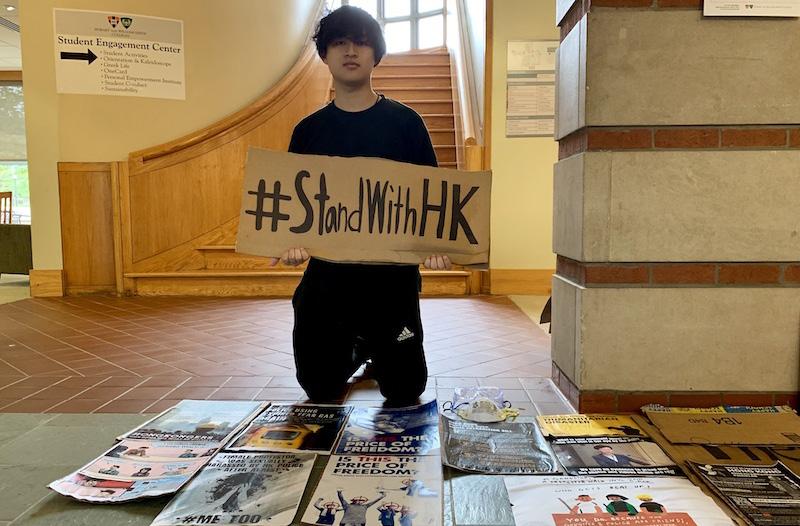
On Monday, Sept. 2, Hong Kong student nationals at high schools and universities across the globe participated in a coordinated student strike.
“I feel like that I had to do something as well,” he said.
Earlier last week, Ho carried his nation’s flag while holding a sign that read, “#StandWithHK” during the Convocation flag-bearing entrance, and even after mounting his banner, he stood behind the Hong Kong flag for the entire duration of the ceremony.
A week removed from the Convocation celebration, he has created nearly hundreds of signs about the Hong Kong protests, placing them in many rows on top of the grass outside of the Scandling Center building until he eventually moved inside due to rain.
Aside from the occasional conversation or posed query from a passerby, the majority of his day was spent silently protesting inside the building, bringing attention to terrorism attacks that took place on subways and in train stations as well as accusations of police brutality exhibited upon Hong Kong civilians.
Although he is on the opposite side of the world, thousands of miles away, Ho still feels connected to his community and their struggle, especially when he actively searches for and acquires directly-sourced eyewitness accounts from LIHKJG Forum, a Hong Kong based forum website which resembles Reddit.
For Ho, he calls for Americans to show their support by contacting their federal representatives about the Hong Kong Human Rights and Democracy Act, a bill that has been introduced into both the House of Representatives and Senate with bipartisan support.
As an undergraduate student among a globally diverse learning community, Ho has engaged with many exchange students, including some of whom hail from China, and shared that he has experienced a mixed-bag of responses from Chinese nationals.
“They are civilized to discuss this matter with me but some of them try to threaten me in message,” he stated.
Ho considers some of the comments directed towards him as hate speech. One student allegedly telling him that he was a “useless teenager,” and another calling him an “idiot” in their native language of Chinese.
However, Ho has promised that he will not stop spreading his peaceful protests across the campus until the international conflict ceases.
“Every time I wake-up and I see all the news, all of these terrible things, I feel helpless because I am here and I can’t do anything about it; but at this campus I feel so free, I don’t feel any threat,” he said.
First-Year Class Profile
By Malika Panjabi
The Classes of 2023 are made up of athletes, artists, future politicians and students who are determined to make their mark on the school. Each seeing the school through a different perspective, as a different opportunity to make the most of their education, this first-year class has some thoughts about Hobart and William Smith Colleges.
In talking to first-year students about why they chose to attend HWS, three things came up: study abroad, community, and financial aid. Ranking in the top 5 for study abroad, HWS provides a variety of countries and programs for students. Johanna Golden ’23 said she was determined to study abroad at least once in places such as Bali or Brussels.
Another reason for students’ choosing to attend HWS was the close community. Smaller class sizes, professors that know your name, and the fact that you’re more than a number in a class means more. Students look for that connection and want to be able to have a relationship with professors that extends beyond the classroom. Whether it’s a simple ‘how was your day’ at the start of class or ‘come by office hours to talk to more’ in passing, students appreciate it.
The last aspect, financial aid, was mentioned the most. Daniella Brown ’23 explicitly said that the financial aid the school offered her was one of the reasons why she even decided to consider the school. Many students benefited from the aid the school gave them, making it easier for them to join a community they were glad to be a part of.
While these are the reasons why firstyear students came to the HWS, there are different reasons why they have decided to stay here. Ashley Edwards ’23 came to HWS because of “the beautiful lake and close-knit community.” She can call this place her home for the next four years because of the friends she has made and the classes she has been able to take.
That rings true for many others as well. Several first-years attribute finding their place to the Intercultural Affairs House. On a campus that is predominantly white, diversity is something students want. “Students of color are bound to feel a little left out or overwhelmed about being in a space that you don’t see representation in,” Fatou Diokhane ’23 says.
Diokhane believes that “the school really tries to include everyone and promote diversity.” One of the main ways it does this is through the IC house, which brings students together and provides a space for everyone to learn more about different cultures and religions. As Kevin Lima ’23 states, “The IC House must stay.” His sentiment is echoed by many.
Just as the first years are new on campus, so is President Joyce P. Jacobsen. Having a new president didn’t affect many students’ decision to attend HWS, as students felt that a new president might be a good welcome. Fondly recalling President Jacobsen’s rendition of “Old Town Road” during Orientation, a student, who asked to remain anonymous, felt confident in knowing that they made a good choice, despite being away from home for the first time.
Some students are a mere 20 minutes away from home, others 6 hours, and many even come from the opposite coast. Being in a new place is a common fear among all first years, which is why meeting new people and working through the school, day by day, helps. The students here want to do big things and are surrounded by other students who are more than willing to help them get there. The Classes of 2023 are capable of great things. They’re determined to make the most of their time here at HWS, and HWS is determined to help them do that.
5FRIDAY, SEPTEMBER 27, 2019
News
‘23
Photo credit: Gabriel Pietrorazio
Herald Contributor Herald Contributor
News
Low Turnout in Student Elections
By Olivia Rowland ‘21
With the beginning of a new school year comes another round of student government elections. As the Herald has reported in the past, turnout for these elections is usually small, and this year’s elections were no exception.
The main elections for class presidents, the William Smith Congress (WSC) executive board, and the Hobart Student Government (HSG) executive board were held on Friday, Sept. 13. Runoff elections for the Hobart first-year class president and William Smith junior class president were held the following Thursday, Sept. 16.
The new William Smith class presidents are Gabriela Nieves ’23, Isabel Urquiza ’22, Carling Landeche ’21, and Val Cuellar ’20. For Hobart, William Koepp ’23, Gib Shea ’22, Kevin Cervantes ’21, and Tanner Arnold ’20 were elected to serve as class presidents.
Margo Grapshi ’22 was elected to join the WSC executive board as secretary. The new executive board for HSG consists of Robert Russell ’22, president; Mitchell Thompson ’23, vice president; Aaron Hittman ’22, treasurer; and Andrew Gudea ’22, secretary.
In both elections, significantly more William Smith students voted than Hobart students. 99 Hobart students voted in the HSG elections, and 165 William Smith students voted in the WSC election, even though the WSC election had only one candidate for one position and the HSG government had four open positions, one of which was competitive with two candidates running.
For class presidents, 100 Hobart students voted compared to 201 William Smith students, excluding the junior class president runoff election in which 85 William Smith students voted. Despite the fact that the Hobart first-year class president election was the most competitive with three candidates, only 37 first-year Hobart students voted in the election. 37 also voted in the following runoff election.
Based on student election data from this year and previous years, it seems that Hobart students become less likely to vote as they spend more time at college, while William Smith students’ engagement remains relatively steady across all class
years.
This year, only 15 Hobart seniors voted for their class president, compared to the 56 William Smith seniors who voted for theirs. First-year voter engagement among Hobart and William Smith was, however, about the same. The total number of first-year William Smith students voting for class president was 38, only one more than first-year Hobart students.
Aside from these significant differences in student turnout based on college, turnout was low across the board. Only 264 students voted in the WSC and HSG elections, and only 340 voted in the class president elections and the two runoffs. It is also likely that there was significant overlap among students voting in the two elections.
Just as low engagement in student elections is nothing new, neither are many of the reasons behind it. One central reason is the lack of competitive elections, or those with at least two candidates running. Out of 13 elections, only four had more than one candidate. One of those was the election for William Smith junior class president, which originally had no candidates running and only entered a runoff election after write-in candidates appeared the day of the original election.
Without an actual competition, students may feel that their vote would not matter, since the election outcome would be the same whether or not they voted. However, the lack of engagement in the Hobart first-year class president election, as noted above, did not prompt any more Hobart students to participate in the original election or the runoff.
Another possibility for low turnout unique to HWS is the coordinate system, which sets up different student governments for Hobart and William Smith. While having separate governments ensures that an equal number of Hobart and William Smith students are elected into student government positions, it prevents students from being able to vote for a student in the other college. In other words, Hobart students cannot vote for any William Smith students and vice versa, even though both student governments work together and affect the entire student body.
Audrey Platt ’21, co-president of HWS
Votes and Civic Engagement along with Bart Lahiff ’20, agrees that this may contribute to low student voter engagement. “We all have the opportunity to vote for our respective colleges, and yet within these coordinate conversations so much is going on and there is so much contention on campus with all these different divides,” she says. “We still don’t have incredible voter turnout, necessarily speaking.”
Platt also thinks that students don’t see what student governments do on campus. “There’s not a lot of understanding about how our system works right now,” she explains.
Despite the fact that many barriers to student voter engagement exist specifically at HWS, low turnout among college students is a national problem.
As Platt notes, “This is only a microcosm of lack of engagement across not only the nation but other colleges.” Most colleges, she says, have a small minority of students who are most engaged, and HWS is no exception.
In her work with the Center for Community Engagement and Service Learning (CCESL), Platt aims to increase civic engagement on campus. This involves registering students to vote, helping students use their voices, and getting students engaged in supporting the voices of others as allies.
HWS Votes has also focused on getting students to participate in local politics in Geneva, where elections make a big difference in government. Platt thinks that student participation could “bridge that gap between the Colleges and Geneva.”
As a Student Trustee, Platt herself knows what it means to have an elected position. “I am super stoked to have a leadership position that I was elected into at the Colleges,” she says.
“The involvement in student government, the involvement in who’s representing your class, who’s representing your student body, is really unique,” says Platt. “We just need to start to pick up the pace with engagement on campus.”
HWS Votes will be working throughout the school year to engage students as voters. Students who want to get involved with campus politics can also attend WSC and HSG meetings, which are held Tuesdays at 8:00 p.m. in Coxe Hall.
HWS Herald Crossword
Down:
of religious studies,
campus.
Across:
longest serving president of HWS.
woman in America to receive a
medicine and an icon here at HWS.
currently rests on the art campus.
of the artdepartment
new HWS president.
mascot for William Smith College.
oldest standing academic building in NYS and currently operates as an all-male dorm on campus.
of computer science, geoscience, and the department of mathematics.
the Hobart and William Smith deans
ces and is the home of a collection of language departments on campus.
of music, dance, theater, and media and society on campus.
colleges library.
the cafe and cafeteria for the colleges.
of the political science, anthropology/sociology, economics and Asian languages and cultures departments and was designed at the turn of the 21st century to facilitate and optimize student learning.
13.The mascot for Hobart College.
facility that houses the largest indoor open space on campus.
6 FRIDAY, SEPTEMBER 27, 2019
Build your own custom worksheet at education.com/worksheet-generator © 2007 - 2019 Education.com
3 4 5 8 9 10 11 12 13
1.Home
English, philosophy, and comparative literature on
2.Home
and
3.The
4.The
5.The first
PhD. in
6.The
7.Hub
8.The
9.The
10.Home
11.Houses
11.Houses
offi
12.Home
14.Monumentalathletic
® Copy Editor

 By Elise Donovan ’22
By Elise Donovan ’22







 By Maya Striuli ‘22
By Maya Striuli ‘22
